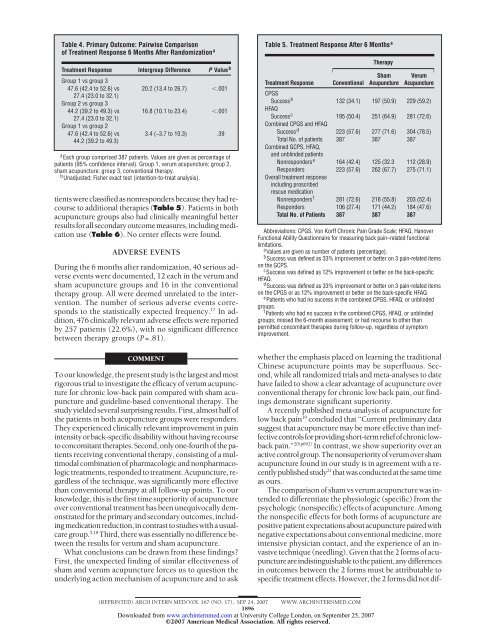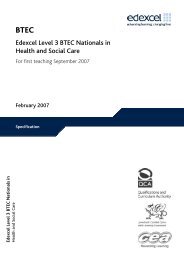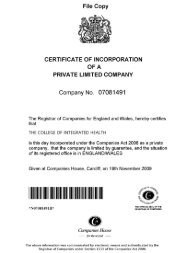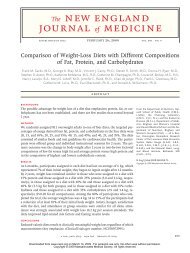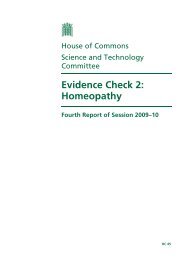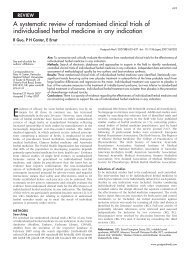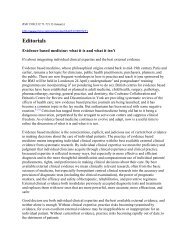German Acupuncture Trials (GERAC) for Chronic Low Back Pain
German Acupuncture Trials (GERAC) for Chronic Low Back Pain
German Acupuncture Trials (GERAC) for Chronic Low Back Pain
Create successful ePaper yourself
Turn your PDF publications into a flip-book with our unique Google optimized e-Paper software.
Table 4. Primary Outcome: Pairwise Comparison<br />
of Treatment Response 6 Months After Randomization a<br />
Treatment Response Intergroup Difference P Value b<br />
Group 1 vs group 3<br />
47.6 (42.4 to 52.6) vs<br />
27.4 (23.0 to 32.1)<br />
Group 2 vs group 3<br />
44.2 (39.2 to 49.3) vs<br />
27.4 (23.0 to 32.1)<br />
Group 1 vs group 2<br />
47.6 (42.4 to 52.6) vs<br />
44.2 (39.2 to 49.3)<br />
20.2 (13.4 to 26.7) �.001<br />
16.8 (10.1 to 23.4) �.001<br />
3.4 (−3.7 to 10.3) .39<br />
a Each group comprised 387 patients. Values are given as percentage of<br />
patients (95% confidence interval). Group 1, verum acupuncture; group 2,<br />
sham acupuncture; group 3, conventional therapy.<br />
b Unadjusted; Fisher exact test (intention-to-treat analysis).<br />
tients were classified as nonresponders because they had recourse<br />
to additional therapies (Table 5). Patients in both<br />
acupuncture groups also had clinically meaningful better<br />
results<strong>for</strong>allsecondaryoutcomemeasures,includingmedication<br />
use (Table 6). No center effects were found.<br />
ADVERSE EVENTS<br />
During the 6 months after randomization, 40 serious adverse<br />
events were documented, 12 each in the verum and<br />
sham acupuncture groups and 16 in the conventional<br />
therapy group. All were deemed unrelated to the intervention.<br />
The number of serious adverse events corresponds<br />
to the statistically expected frequency. 17 In addition,<br />
476 clinically relevant adverse effects were reported<br />
by 257 patients (22.6%), with no significant difference<br />
between therapy groups (P=.81).<br />
COMMENT<br />
To our knowledge, the present study is the largest and most<br />
rigorous trial to investigate the efficacy of verum acupuncture<br />
<strong>for</strong> chronic low-back pain compared with sham acupuncture<br />
and guideline-based conventional therapy. The<br />
study yielded several surprising results. First, almost half of<br />
the patients in both acupuncture groups were responders.<br />
They experienced clinically relevant improvement in pain<br />
intensity or back-specific disability without having recourse<br />
toconcomitanttherapies.Second,onlyone-fourthofthepatients<br />
receiving conventional therapy, consisting of a multimodal<br />
combination of pharmacologic and nonpharmacologic<br />
treatments, responded to treatment. <strong>Acupuncture</strong>, regardless<br />
of the technique, was significantly more effective<br />
than conventional therapy at all follow-up points. To our<br />
knowledge, this is the first time superiority of acupuncture<br />
over conventional treatment has been unequivocally demonstrated<br />
<strong>for</strong> the primary and secondary outcomes, includingmedicationreduction,incontrasttostudieswithausualcare<br />
group. 5,18 Third, there was essentially no difference between<br />
the results <strong>for</strong> verum and sham acupuncture.<br />
What conclusions can be drawn from these findings?<br />
First, the unexpected finding of similar effectiveness of<br />
sham and verum acupuncture <strong>for</strong>ces us to question the<br />
underlying action mechanism of acupuncture and to ask<br />
Table 5. Treatment Response After 6 Months a<br />
Treatment Response<br />
Conventional<br />
Therapy<br />
Sham<br />
<strong>Acupuncture</strong><br />
Verum<br />
<strong>Acupuncture</strong><br />
CPGS<br />
Success b 132 (34.1) 197 (50.9) 229 (59.2)<br />
HFAQ<br />
Success c 195 (50.4) 251 (64.9) 281 (72.6)<br />
Combined CPGS and HFAQ<br />
Success d 223 (57.6) 277 (71.6) 304 (78.5)<br />
Total No. of patients 387 387 387<br />
Combined GCPS, HFAQ,<br />
and unblinded patients<br />
Nonresponders e 164 (42.4) 125 (32.3 112 (28.9)<br />
Responders 223 (57.6) 262 (67.7) 275 (71.1)<br />
Overall treatment response<br />
including proscribed<br />
rescue medication<br />
Nonresponders f 281 (72.6) 216 (55.8) 203 (52.4)<br />
Responders 106 (27.4) 171 (44.2) 184 (47.6)<br />
Total No. of Patients 387 387 387<br />
Abbreviations: CPGS, Von Korff <strong>Chronic</strong> <strong>Pain</strong> Grade Scale; HFAQ, Hanover<br />
Functional Ability Questionnaire <strong>for</strong> measuring back pain–related functional<br />
limitations.<br />
a Values are given as number of patients (percentage).<br />
b Success was defined as 33% improvement or better on 3 pain-related items<br />
on the GCPS.<br />
c Success was defined as 12% improvement or better on the back-specific<br />
HFAQ.<br />
d Success was defined as 33% improvement or better on 3 pain-related items<br />
on the CPGS or as 12% improvement or better on the back-specific HFAQ.<br />
e Patients who had no success in the combined CPGS, HFAQ, or unblinded<br />
groups.<br />
f Patients who had no success in the combined CPGS, HFAQ, or unblinded<br />
groups; missed the 6-month assessment; or had recourse to other than<br />
permitted concomitant therapies during follow-up, regardless of symptom<br />
improvement.<br />
whether the emphasis placed on learning the traditional<br />
Chinese acupuncture points may be superfluous. Second,<br />
while all randomized trials and meta-analyses to date<br />
have failed to show a clear advantage of acupuncture over<br />
conventional therapy <strong>for</strong> chronic low back pain, our findings<br />
demonstrate significant superiority.<br />
A recently published meta-analysis of acupuncture <strong>for</strong><br />
low back pain 19 concluded that “Current preliminary data<br />
suggest that acupuncture may be more effective than ineffectivecontrols<strong>for</strong>providingshort-termreliefofchroniclowback<br />
pain.” 20(p692) In contrast, we show superiority over an<br />
activecontrolgroup.Thenonsuperiorityofverumoversham<br />
acupuncture found in our study is in agreement with a recentlypublishedstudy<br />
21 thatwasconductedatthesametime<br />
as ours.<br />
The comparison of sham vs verum acupuncture was intended<br />
to differentiate the physiologic (specific) from the<br />
psychologic (nonspecific) effects of acupuncture. Among<br />
the nonspecific effects <strong>for</strong> both <strong>for</strong>ms of acupuncture are<br />
positivepatientexpectationsaboutacupuncturepairedwith<br />
negative expectations about conventional medicine, more<br />
intensive physician contact, and the experience of an invasive<br />
technique (needling). Given that the 2 <strong>for</strong>ms of acupunctureareindistinguishabletothepatient,anydifferences<br />
in outcomes between the 2 <strong>for</strong>ms must be attributable to<br />
specific treatment effects. However, the 2 <strong>for</strong>ms did not dif-<br />
(REPRINTED) ARCH INTERN MED/ VOL 167 (NO. 17), SEP 24, 2007 WWW.ARCHINTERNMED.COM<br />
1896<br />
Downloaded from<br />
www.archinternmed.com at University College London, on September 25, 2007<br />
©2007 American Medical Association. All rights reserved.


